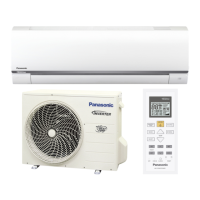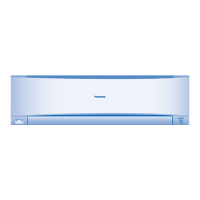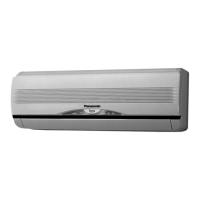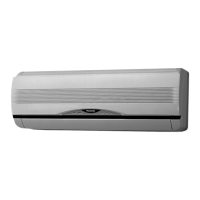33
AIR PURGING METHOD IS PROHIBITED FOR R32 SYSTEM
12.3.3 Air Tightness Test on the Refrigerating System
Do not purge the air with refrigerants but use a vacuum pump to vacuum the installation.
There is no extra refrigerant in the outdoor unit for air purging.
Before system is charged with refrigerant and before the refrigerating system is put into operation, below site test
procedure and acceptance criteria shall be verified by the certified technicians, and/or the installer.
Be sure to check whole system for gas leakage.
Notes:
Recommended use of any of the following leak detector,
I) Universal Sniffer leak detector
II) Electronic halogen leak detector
III) Ultrasonic Leak Detector
1) Connect a charging hose with a push pin to the Low side of a charging set and the service port of the 3-way valve.
2) Attach the gauge manifold set correctly and tightly. Make sure that both valves of the manifold gauge (low pressure
and high pressure) is in close position.
3) Connect the center hose of the manifold gauge to a vacuum pump.
4) Turn on the power switch of the vacuum pump, then turn open the low side manifold gauge valve and make sure
that the needle in the gauge moves from 0 cmHg (0 MPa) to –76 cmHg (–0.1 MPa) or vacuum until 500 microns is
achieved. This process continues for approximately ten minutes. Then close the low side manifold gauge valve.
5) Remove the vacuum pump from the centre hose and connect the center hose to cylinder of any applicable inert gas
as test gas.
6) Charge test gas into the system and wait until the pressure within the system to reach
min. 1.04 MPa (10.4 barg).
7) Wait and monitor the pressure reading on the gauges. Check if there is any pressure drop. Waiting time depends on
the size of the system.
8) If there is any pressure drop, perform step 9-12. If there is no pressure drop, perform step 13.
9) Use Gas Leak Detector to check for leaks. Must use the detection equipment with a
sensitivity of 5 grams per year of test gas or better.
10) Move the probe along the air conditioning system to check for leaks, and mark for repair.
11) Any leak detected and marked shall be repaired.
12) After repair, repeat evacuation steps 3-4 and tightness test steps 5-7.
Check the pressure drop as in step 8.
13) If no leak,
Recover the test gas. Perform evacuation
of steps 3-4.
Then proceed to step 14.
14) Disconnect the charging hose from the
service port of the 3-way valve.
15) Tighten the service port caps of the 3-way
valve at a torque of 18 N•m with a torque
wrench.
16) Remove the valve caps of both of the 2-way
valve and 3-way valve.
17) Open both of the valves, using a hexagonal
wrench (4 mm). It is recommended to allow
refrigerant slowly fl ow into the refrigerant
system to prevent refrigerant freezing.
Slightly open 2-way valve for 5 seconds
then close the valve. Repeat this action for
3 cycles then fully open the valve.
18) Mount back the valve caps onto the 2-way
valve and the 3-way valve to complete this
process.
Preparation
(Step 1-2)
Evacuation
(Step 3-4)
Tightness Test
with Inert Gas
(Step 5-7)
Pressure drop?
(Step 8)
YES
NO
Leak detection
and repair
(Step 9-12)
Recovery of Test
Gas
(Step 13)
Evacuation
(Step 3-4)
Open 2 and 3
valves
(Step 14-18)
Complete
Liquid side
Tank
Cylinder
Indoor unit
Inert
gas
Vacuum
pump
OPEN
CLOSE
Gas side
Two-way valve
Close
Close
Three-way valve
Outdoor unit
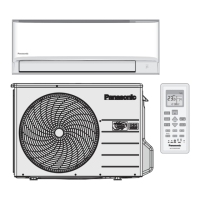
